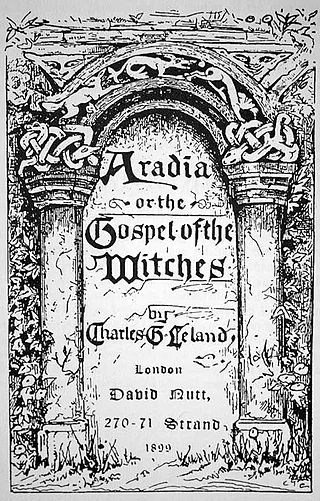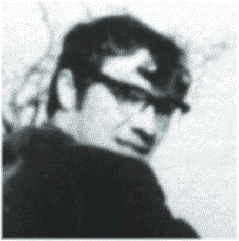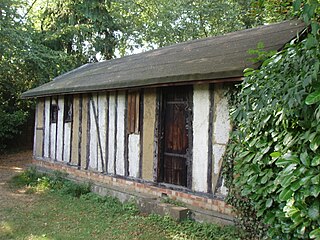Origins
Gardner
Gardner's Witchcraft Today was published in 1954. The book claimed to report on the contemporary practice of Pagan religious witchcraft in England, which had supposedly survived as an underground religion for centuries. Ritual nudity was included as a regular part of Wiccan practice, but in the modern day it is mainly used by Alexandrian, Georgian, and Blue Star Wiccans. The "Charge of the Goddess", a part of Gardnerian ritual liturgy, does instruct Wiccans to practice ritual in the nude. Gardner spent several years in India, and may have picked up the concept from the Digambara Jains, a religious sect in which the monks may not wear clothing. [1]
The term Digambara literally means "sky-clad". [2] England had close links with India at the time when Wicca first became public in England, so this usage could well have been familiar to English speakers with a knowledge of Far Eastern religions. In particular, Gerald Gardner, who first popularized Wicca in England, was a noted folklorist with an interest in Far Eastern culture who spent much of his adult life in Ceylon and Burma, so it seems very plausible that he could have been familiar with this Hindu term. [1]
Dr. Leo Ruickbie also notes that the traditional and artistic representation of witches cannot be overlooked as a source for nudity in Gardner's system, citing artists such as Albrecht Dürer and Salvator Rosa. [3]
Aradia
The origins of this instruction have been traced to Aradia, or the Gospel of the Witches . [4] [3] The following speech by Aradia appears at the end of the book's first chapter;
And as the sign that ye are truly free,
Ye shall be naked in your rites, both men
And women also: this shall last until
The last of your oppressors shall be dead; [5]
Doreen Valiente, one of Gardner's priestesses, recalls Gardner's surprise at Valiente's recognition of material from Aradia in the original version of the "Charge" that she was given. [6] Valiente later rewrote the "Charge", preserving the lines from Aradia. Valiente's version was then widely circulated and reprinted.
Accepting Aradia as the source of skyclad practice, Robert Chartowich points to the 1998 Pazzaglini translation of these lines, which read "Men and Women / You will all be naked, until / Yet he shall be dead, the last / Of your oppressors is dead." Chartowich argues that the ritual nudity of Wicca was based upon Leland's mistranslation of these lines by incorporating the clause "in your rites". [7]
Outside Wiccan traditions
Ritual nudity is not exclusive to traditional Wicca. Amongst those groups that do, only some rituals may involve ritual nudity. The Arician tradition, as an example, practices skyclad for six months of the year, and performs their ceremonies in ritual robes for the other half of the year. [8] Within, and especially outside of, specific areas of Wicca and Pagan, reasons other than tradition may be given to explain a preference for skyclad worship. Starhawk states in Spiral Dance , "The naked body represents truth, the truth that goes deeper than social custom" and "is a sign that a Witch's loyalty is to the truth before any ideology or any comforting illusions." [9]
The Charge of the Goddess is an inspirational text often used in the neopagan religion of Wicca. The Charge of the Goddess is recited during most rituals in which the Wiccan priest/priestess is expected to represent, and/or embody, the Goddess within the sacred circle, and is often spoken by the High Priest/Priestess after the ritual of Drawing Down the Moon.

Gardnerian Wicca, or Gardnerian witchcraft, is a tradition in the neopagan religion of Wicca, whose members can trace initiatory descent from Gerald Gardner. The tradition is itself named after Gardner (1884–1964), a British civil servant and amateur scholar of magic. The term "Gardnerian" was probably coined by the founder of Cochranian Witchcraft, Robert Cochrane in the 1950s or 1960s, who himself left that tradition to found his own.

Wicca, also known as "The Craft", is a modern pagan, syncretic, earth-centered religion. Considered a new religious movement by scholars of religion, the path evolved from Western esotericism, developed in England during the first half of the 20th century, and was introduced to the public in 1954 by Gerald Gardner, a retired British civil servant. Wicca draws upon ancient pagan and 20th-century Hermetic motifs for theological and ritual purposes. Doreen Valiente joined Gardner in the 1950s, further building Wicca's liturgical tradition of beliefs, principles, and practices, disseminated through published books as well as secret written and oral teachings passed along to initiates.
Aradia is one of the principal figures in the American folklorist Charles Godfrey Leland's 1899 work Aradia, or the Gospel of the Witches, which he believed to be a genuine religious text used by a group of pagan witches in Tuscany, a claim that has subsequently been disputed by other folklorists and historians. In Leland's Gospel, Aradia is portrayed as a messiah who was sent to Earth in order to teach the oppressed peasants how to perform witchcraft to use against the Roman Catholic Church and the upper classes.

A Book of Shadows is a book containing religious text and instructions for magical rituals found within the Neopagan religion of Wicca. Since its conception, it has made its way into many pagan practices and paths. The most famous Book of Shadows was created by the pioneering Wiccan Gerald Gardner sometime in the late 1940s or early 1950s, and which he utilised first in his Bricket Wood coven and then in other covens which he founded in following decades. The Book of Shadows is also used by other Wiccan traditions, such as Alexandrian Wicca and Mohsianism, and with the rise of books teaching people how to begin following non-initiatory Wicca in the 1970s onward, the idea of the Book of Shadows was then further propagated amongst solitary practitioners unconnected to earlier, initiatory traditions.
Alexandrian Wicca or Alexandrian Witchcraft is a tradition of the Neopagan religion of Wicca, founded by Alex Sanders who, with his wife Maxine Sanders, established the tradition in the United Kingdom in the 1960s. Alexandrian Wicca is similar in many ways to Gardnerian Wicca, and receives regular mention in books on Wicca as one of the religion's most widely recognised traditions.
Stregheria is a neo-pagan tradition similar to Wicca, with Italian and Italian American origins. While most practitioners consider Stregheria to be a distinct tradition from Wicca, some academics consider it to be a form of Wicca or an offshoot. Both have similar beliefs and practices. For example, Stregheria honors a pantheon centered on a Moon Goddess and a Horned God, similar to Wiccan views of divinity.

Doreen Edith Dominy Valiente was an English Wiccan who was responsible for writing much of the early religious liturgy within the tradition of Gardnerian Wicca. An author and poet, she also published five books dealing with Wicca and related esoteric subjects.

The New Forest coven was an alleged group of pagan witches who met around the area of the New Forest in Southern England during the early 20th century. According to his own claims, in September 1939, a British occultist named Gerald Gardner was initiated into the coven and subsequently used its beliefs and practices as a basis from which he formed the tradition of Gardnerian Wicca. Gardner described some of his experiences with the coven in his published books Witchcraft Today (1954) and The Meaning of Witchcraft (1959) although on the whole revealed little about it, saying he was respecting the privacy of its members. Meanwhile, another occultist, Louis Wilkinson, corroborated Gardner's claims by revealing in an interview with the writer Francis X. King that he too had encountered the coven and expanded on some of the information that Gardner had provided about them. According to Gardner, the faith they followed was the Witch-Cult, a supposed pagan religion that had survived in secret after the Christianization of Europe. This was in keeping with the now-discredited theories of Margaret Murray and her supporters.

A craft name, also referred to as a magical name, is a secondary religious name often adopted by practitioners of Wicca and other forms of Neopagan witchcraft or magic. Craft names may be adopted as a means of protecting one's privacy, as an expression of religious devotion, or as a part of an initiation ritual. It may also be used as a protective method, as it is believed by some that one's "true name" can be used to identify that person for the purpose of magical activities.

Aradia, or the Gospel of the Witches is a book composed by the American folklorist Charles Godfrey Leland that was published in 1899. It contains what he believed was the religious text of a group of pagan witches in Tuscany, Italy, that documented their beliefs and rituals. Historians and folklorists have disputed the existence of such a group. During the 20th century, the book was influential in the development of the contemporary Pagan religion of Wicca.
Drawing down the Moon is a central ritual in many contemporary Wiccan traditions. During the ritual, a coven's High Priestess enters a trance and requests that the Goddess or Triple Goddess, symbolized by the Moon, enter her body and speak through her. The High Priestess may be aided by the High Priest, who invokes the spirit of the Goddess. During her trance, the Goddess is supposed to speak through the High Priestess.

Robert Cochrane, who was born as Roy Bowers, was an English occultist who founded the tradition of Witchcraft known as The Clan of Tubal Cain.
The history of Wicca documents the rise of the Neopagan religion of Wicca and related witchcraft-based Neopagan religions. Wicca originated in the early 20th century, when it developed amongst secretive covens in England who were basing their religious beliefs and practices upon what they read of the historical witch-cult in the works of such writers as Margaret Murray. It was subsequently founded in the 1950s by Gardner, who claimed to have been initiated into the Craft – as Wicca is often known – by the New Forest coven in 1939. Gardner's form of Wicca, the Gardnerian tradition, was spread by both him and his followers like the High Priestesses Doreen Valiente, Patricia Crowther and Eleanor Bone into other parts of the British Isles, and also into other, predominantly English-speaking, countries across the world. In the 1960s, new figures arose in Britain who popularized their own forms of the religion, including Robert Cochrane, Sybil Leek and Alex Sanders, and organizations began to be formed to propagate it, such as the Witchcraft Research Association. It was during this decade that the faith was transported to the United States, where it was further adapted into new traditions such as Feri, 1734 and Dianic Wicca in the ensuing decades, and where organizations such as the Covenant of the Goddess were formed.

Wiccan views of divinity are generally theistic, and revolve around a Goddess and a Horned God, thereby being generally dualistic. In traditional Wicca, as expressed in the writings of Gerald Gardner and Doreen Valiente, the emphasis is on the theme of divine gender polarity, and the God and Goddess are regarded as equal and opposite divine cosmic forces. In some newer forms of Wicca, such as feminist or Dianic Wicca, the Goddess is given primacy or even exclusivity. In some forms of traditional witchcraft that share a similar duotheistic theology, the Horned God is given precedence over the Goddess.

In the neopagan religion of Wicca a range of magical tools are used in ritual practice. Each of these tools has different uses and associations and are commonly used at an altar, inside a magic circle.

Neopagan witchcraft, sometimes referred to as The Craft, is an umbrella term for some neo-pagan traditions that include the practice of magic. These traditions began in the mid-20th century, and many were influenced by the witch-cult hypothesis; a now-rejected theory that persecuted witches in Europe had actually been followers of a surviving pagan religion. The largest and most influential of these movements was Wicca. Some other groups and movements describe themselves as "Traditional Witchcraft" to distinguish themselves from Wicca.

The Bricket Wood coven, or Hertfordshire coven is a coven of Gardnerian witches founded in the 1940s by Gerald Gardner. It is notable for being the first coven in the Gardnerian line, though having its supposed origins in the pre-Gardnerian New Forest coven. The coven formed after Gardner bought a plot at the Fiveacres Country Club, a naturist club in the village of Bricket Wood, Hertfordshire, southern England, and met within the club's grounds. It played a significant part in the history of the neopagan religion of Wicca.

Raymond Howard was an English practitioner of the modern Pagan new religious movement of Wicca. He promoted his tradition, known as the Coven of Atho, through a correspondence course established in the early part of the 1960s.
In Modern English, the term Wicca refers to Wicca, the religion of contemporary Pagan witchcraft. It is used within the Pagan community under competing definitions. One refers to the entirety of the Pagan Witchcraft movement, while the other refers explicitly to traditions included in what is now called British Traditional Wicca.













